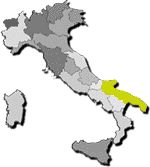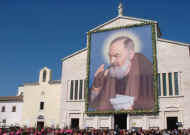Solyss Negroamaro La Corte 2004 – Red wine from Puglia
 Puglia is not generally known for its wine. The grapes are robust, the flavor fruity, and the sugar content is high but the wines from Puglia are, more often than not, combined with other wines to increase their sugar and alcohol content. Occasionally a really good and reasonably priced table wine comes out of this southeastern region of Italy. I must admit that my experience is formed from traditional Italian knowledge where wines from Puglia do not get a great deal of respect. In the last 10 years the regional producers have made significant progress creating good quality wines.
Puglia is not generally known for its wine. The grapes are robust, the flavor fruity, and the sugar content is high but the wines from Puglia are, more often than not, combined with other wines to increase their sugar and alcohol content. Occasionally a really good and reasonably priced table wine comes out of this southeastern region of Italy. I must admit that my experience is formed from traditional Italian knowledge where wines from Puglia do not get a great deal of respect. In the last 10 years the regional producers have made significant progress creating good quality wines. Yesterday evening Raffaella prepared Fagiano alla Cacciatora con Funghi, another in dish in our series featuring Pheasant. The bottle of Solyss had been enticing us for the last couple of weeks and we thought the savory Pheasant with the rich mushroom sauce needed a flavorful wine to balance. Our concern was that Solyss might be a bit too young and fruity similar to a Barbara table wine but we were presently surprised. Solyss ages only 6 months in oak barrels and is just less than 2 years old. We would think of this as infanticide for most wines but our great friend Italian Wine Guy told us that Solyss was designed for consumption as soon as it is distributed.
Yesterday evening Raffaella prepared Fagiano alla Cacciatora con Funghi, another in dish in our series featuring Pheasant. The bottle of Solyss had been enticing us for the last couple of weeks and we thought the savory Pheasant with the rich mushroom sauce needed a flavorful wine to balance. Our concern was that Solyss might be a bit too young and fruity similar to a Barbara table wine but we were presently surprised. Solyss ages only 6 months in oak barrels and is just less than 2 years old. We would think of this as infanticide for most wines but our great friend Italian Wine Guy told us that Solyss was designed for consumption as soon as it is distributed.Our risk was well compensated. The wine was stable and well-rounded without an excess fruitiness. It had enough body to balance the mushrooms, just fruity enough to accentuate the wild fowl flavor of the Pheasant, and just enough tannins to clean the palate. As baby bear in Goldilocks would say, “It was just right!”
 Grape: Negroamaro 100%.
Grape: Negroamaro 100%.Color: Scarlet Red with Violet highlights.
Bouquet: Jasmine and Eucalyptus, ripe red fruits and spices.
Flavor: Medium-bodied flavor, red berries, currant, dried herbs, the residual is a hint of blueberries.
Alcohol Content: 14 %
Serving Temperature: 15-18 c.
Decanting: None
Pouring: Pour slowly, angle at 55 degrees or less.
Glass: Red Wine Glass.
Aging: This wine was first produced in 2000 so its capability to age is unknown at this time however, given the limited time in barrels and its fruity nature I would think that this should be consumed within a couple of years of purchase.
Tags: La Corte Red Wine Italian Wine Puglia Sommelier Food and Wine Travel Italy
Labels: Italian Wine, Puglia, Red Wine, Wine








